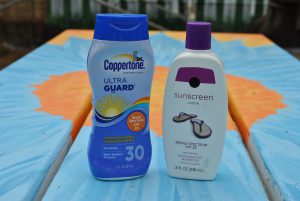Article and audio introduction by Samantha Kennedy, Family and Consumer Sciences
The sun is already scorching here in Wakulla County and it is not even officially summer yet. It is a constant and relentless companion when we are outside, pushing temperatures into the mid to upper 90s and, if we are not careful, damaging our skin. We all know sunscreen is a great way to protect our skin from damaging ultraviolet (UV) rays. But which sunscreen works the best and what do all those numbers and letters mean? Here are the answers to a few common sunscreen questions.
I tan instead of burn. Do I still need to use sunscreen? The short answer is yes. Tanned skin is damaged skin. Even if it is not burned, the UV rays from the sun can still damage the tissue and cells underneath the surface. It is always a good idea to use sunscreen no matter what.
What does broad spectrum mean? There are two major types of UV rays: UVA and UVB. UVA rays generally do not cause a visible sunburn, but can penetrate deeper than UVB rays and damage cells below the surface. UVA rays are major contributors to wrinkles. UVB rays, on the other hand, are the primary cause of sunburn. Broad spectrum sunscreens protect against both kinds of UV rays and are recommended for everyday use.

SPF: What’s that? SPF stands for Sun Protection Factor and is a rating scale for how effectively a sunscreen protects against burns caused by UVB rays. Generally, the higher the SPF, the better the protection. For example, I start to burn after only 15 minutes in the sun. If I apply an SPF 30 sunscreen, it should take 30 times longer, or 450 minutes (7.5 hours), for me to burn.
Wait, really? In theory, yes. But in reality, it does not work like that. Factors such as sweating, swimming, and toweling off are not included in the time factor of SPF. That means that one application of sunscreen will not be sufficiently effective to protect against the sun all day.
But my sunscreen says it is water resistant. That means I do not need to reapply, right? Wrong. Even “water resistant” or “sweatproof” or “sport” sunscreens wear off in water or during sweating. It is recommended that sunscreen be reapplied every two hours or after swimming, sweating, and toweling off in order to achieve the best results.
But if I use SPF 30, does that mean I am protected twice as much as if I use SPF 15? Not quite. The science behind SPF is a little complicated, but basically, twice the SPF does not mean twice the level of UVB protection. SPF 15 protects against 90 percent of UVB radiation already, so SPF 30 cannot protect twice as much. That being said, SPF 30 is the most recommended level for consumers.
Sunscreen can be expensive. Can I get away with using just a little bit to save money? Do not skimp! Sunscreen does not need to be expensive to be effective. The key is to use adequate amounts – at least 1 ounce (3 tablespoons) – and reapply often to ensure proper skin coverage.
Remember, sunscreen is most effective when used properly and in conjunction with other sun safety practices like wearing a hat and loose clothing, seeking shade, and avoiding the sun during the hottest part of the day.
For more information, please call Samantha Kennedy, Family and Consumer Sciences agent, at (850) 926-3931.
Extension classes are open to everyone regardless of race, creed, color, religion, age, disability, sex, sexual orientation, marital status, national origin, political opinions or affiliations.
 0
0
